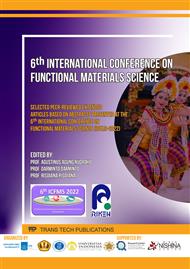p.39
p.47
p.55
p.63
p.71
p.77
p.85
p.93
p.99
Carbonization at Varying Temperatures of PVA-Derived Nanofibers Fabricated by Electrospinning
Abstract:
This research was conducted to determine the morphology, dimensions, and structure of carbon-nanofibers, using polyvinyl alcohol (PVA) as a source of polymer fibers fabricated by electrospinning technique, and given variations in carbonization temperature. Variations in temperature during the carbonization process are carried out to see changes in the structure and morphology of the carbon nanofibers formed. characterization by conducting XRD and SEM tests to determine the structure and morphology of the carbon nanofibers produced, it is seen that the amorphous carbon structure of the nanofibers produced is in the shape of random fibers and tends to be straight without beads. The results obtained from the XRD test, it appears that the structure is amorphous with two peaks that appear during the test, the two peaks are typical of amorphous carbon peaks, so that the fiber that has been formed, then with the carbonization process changes its structure to carbon nanofiber. Unique results were obtained when PVA nanofibers were characterized by SEM, namely the diameter of the fibers formed before and after the carbonization process had sizes in the range of 40 to 50 nanometers, these results were influenced by the process of initial formation of nanofibers using an electrospinning system.
Info:
Periodical:
Pages:
71-76
Citation:
Online since:
July 2023
Keywords:
Price:
Сopyright:
© 2023 Trans Tech Publications Ltd. All Rights Reserved
Share:
Citation:



